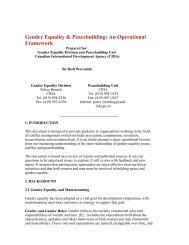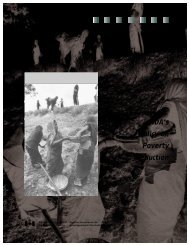Concepts and practices in agricultural extension in developing ...
Concepts and practices in agricultural extension in developing ...
Concepts and practices in agricultural extension in developing ...
- No tags were found...
Create successful ePaper yourself
Turn your PDF publications into a flip-book with our unique Google optimized e-Paper software.
• emergence <strong>and</strong> wider acceptance of participatory research methods• more susta<strong>in</strong>able approaches to <strong>extension</strong> fund<strong>in</strong>g <strong>in</strong>volv<strong>in</strong>g greater flexibility <strong>and</strong> multiplepartners (Gustafson 1991)—pluralism <strong>in</strong> service provision• fall of T&V systems <strong>and</strong> the emergence of the new approaches such as Farmer Field Schools (FFS)• new role for <strong>extension</strong> staff—a more facilitat<strong>in</strong>g <strong>and</strong> catalytic role• greater focus on chang<strong>in</strong>g the m<strong>in</strong>dset of change agents.2.2.6 Current scenario: Diversity <strong>and</strong> <strong>in</strong>stitutional pluralismMuch literature (Schwartz <strong>and</strong> Kampen 1 1992; World Bank 1995; Contado 1997) suggested the needfor a pluralistic <strong>extension</strong> system because public <strong>extension</strong> services need to be accountable to both theclients of the services <strong>and</strong> the wider population. Contado (1997) identified a number of advantages thata national pluralistic policy of <strong>extension</strong> will br<strong>in</strong>g about:• It encourages wider participation <strong>in</strong> provid<strong>in</strong>g resource support <strong>and</strong> control of the <strong>extension</strong>program of the country. As a consequence, more resources are allocated for <strong>extension</strong> or at least aclearer account<strong>in</strong>g of resources devoted to <strong>extension</strong> is achieved.• It creates complementarity <strong>and</strong> synergy <strong>in</strong> the use of resources for <strong>extension</strong> by different donors,which are recognized as part of the pluralistic <strong>extension</strong> policy.• Research <strong>and</strong> <strong>extension</strong> l<strong>in</strong>kage is made functional <strong>in</strong> the field.• It creates a cohesive critical mass of <strong>extension</strong> people who could address large numbers offarmers as well as the <strong>in</strong>creas<strong>in</strong>g variety <strong>and</strong> complexity of subject matters needed by farmers.• It lessens the resource burden upon the central government, or on a s<strong>in</strong>gle agency, or on theprivate sector or on farmers themselves.National reforms <strong>and</strong> other <strong>in</strong>itiatives that <strong>in</strong> essence aim at an optimum mix of <strong>in</strong>stitutional pluralismhave followed different paths for achiev<strong>in</strong>g their objectives. Grassroots associations, the NGO sector,farmers’ associations are major stakeholders <strong>in</strong> this process.Potential providers of <strong>agricultural</strong> <strong>extension</strong> services (Table 2.1) fall <strong>in</strong>to three ma<strong>in</strong> groups: the publicsector, the private nonprofit sector <strong>and</strong> the private for-profit sector. Dist<strong>in</strong>ctions between variousproviders are important because of the range of services each typically offers, <strong>and</strong> the <strong>in</strong>centives theyhave for deliver<strong>in</strong>g these services. The private (profit) sector <strong>in</strong>cludes all agents whose objective is togenerate profits directly or <strong>in</strong>directly for their owners, members or shareholders. The private nonprofitsector differs from the profit sector <strong>in</strong> one important respect: rather than distribut<strong>in</strong>g the residualearn<strong>in</strong>gs (if any) to <strong>in</strong>dividuals who exercise control, it re<strong>in</strong>vests profits to f<strong>in</strong>ance future activities(Umali-De<strong>in</strong><strong>in</strong>ger 1997).The private-for-profit sector comprises three ma<strong>in</strong> sets of actors. Commercial suppliers of <strong>agricultural</strong><strong>in</strong>puts provide ‘free’ <strong>in</strong>formation <strong>and</strong> advice l<strong>in</strong>ked directly to the use of their technology. They are<strong>in</strong>creas<strong>in</strong>gly concerned to ensure that accurate <strong>in</strong>formation is passed on by <strong>in</strong>put dealers at po<strong>in</strong>t ofsale <strong>and</strong> so may be <strong>in</strong>volved <strong>in</strong> tra<strong>in</strong><strong>in</strong>g <strong>and</strong> provid<strong>in</strong>g technical support to their dealer networks. Atthe other end of the production process, companies which purchase, process <strong>and</strong> market <strong>agricultural</strong>produce provide <strong>in</strong>formation <strong>and</strong> services <strong>in</strong> order to assure quality <strong>and</strong> reliability of supply. Muchless common <strong>in</strong> develop<strong>in</strong>g countries is the autonomous emergence of for-profit organizations (firms,partnerships) or <strong>in</strong>dividuals specializ<strong>in</strong>g <strong>in</strong> provid<strong>in</strong>g consultancy <strong>and</strong> advisory services. However,1. Schwartz <strong>and</strong> Kampen (1992) referred to ‘<strong>extension</strong> pluralism’ as the philosophy where a national <strong>extension</strong> system reflectsdifferent strategies to meet the needs of various agro climates <strong>and</strong> farmers.36





